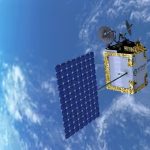LeoSat is expanding the traditional satellite market for telecoms by filling the space between satellite and fibre, says Alex Holvoet, SVP Programme Management at LeoSat.

SatellitePro ME caught up with Alex Holvoet, SVP Programme Management at LeoSat, to get an idea of how a low-Earth orbit satellite constellation can help companies develop their infrastructure to meet the demands of exploding data traffic, boost newly needed capabilities and develop asset portfolios and business models.
It is said that Big Data is the new oil. What infrastructure do telco?s need to be able to compete?
Our world is increasingly data-driven, cloud-based and transnational, creating an ever growing demand to move large quantities of data quickly and securely around the globe. In 2015, global networks for the first time carried more than 1 zetabyte of traffic globally, and traffic is forecast to grow exponentially. We are entering the zetabyte era with big data increasingly driving the need for new infrastructure.
With these developments in mind, there is a clear focus in the telecoms sector on providing the appropriate networks needed to offer always-on connectivity and smart data analysis and management. Up to now, when mobile (telecom) operators were looking for service expansion, a satellite solution was used to complement urban terrestrial networks in semi-rural and rural locations. This allowed them to expand to previously unconnected areas. For some operators, even full out-of-country capacity is based on a satellite service.
As such, growth for mobile operators in coverage areas and services led to increasing bandwidth demand. However, this developed to a point where traditional satellites could not provide the solutions to improve a business case. Alternatives were found in microwave solutions or, in urban areas, fibre was used as a backhaul. While this certainly addressed the issue of capacity, it also introduced new obstacles, including long lead times to install, particularly an issue with customer implementations and high up-front costs.
Now, with the new developments in satellite constellations, there is a better alternative for (mobile) telecom operators in search of growth. The benefits of high speed, low latency and rapid deployment are now available via satellite from low-earth orbit (LEO), providing a resilient and future-proof network to deliver connectivity and services.
What does LEO offer in comparison to traditional satellites (GEO, MEO)?
As much as services from traditional GEO and MEO satellites have been improved, satellite systems are still often perceived in the telecoms world as a last choice for network connectivity when terrestrial infrastructure is not available. Now a new generation of constellations are being designed for even lower orbits, such as LEO (1,200-1,500km). The lower orbit allows high throughput and latencies of below 30ms.
In addition, the newest innovation is adding intersatellite connections. They allow latencies even lower than fibre on long distances (> 6,000km). Using this architecture, which is fundamentally different from satellite?s traditional ?bent-pipe? architecture, there is no need to downlink to gateways to terminate traffic. And when beyond the inter-satellite links the space is also equipped with routing and switching capabilities, then a direct point-to-point spatial MPLS network can be deployed in a very short timeframe.
With these capabilities, native IP is supported in a MPLS configuration. With these new developments, LEO constellations can provide opportunities for telecom operators which will give them access to previously unavailable levels of network performance, combined with worldwide reach.
The benefits of high speed, low latency and rapid deployment are now available via satellite from LEO, providing a resilient and future-proof network to deliver connectivity and services? Alex Holvoet, SVP Programme Management, LeoSat
What does a LEO system comprise, and how does it work?
LeoSat?s new ?touchless? architecture is in fact an optical backbone in space. With light travelling 1.5 times faster through space than through fibre, LeoSat can provide low latency and therefore better performance than fibre over long distances. The system comprises 78 satellites that will orbit the Earth at approximately 1,400km. These satellites will be connected to each other using optical data links (laser beams) that can each carry 10Gb of data. Each satellite will have four links connecting it to the satellites in front, behind, to the left and to the right. This provides a fully meshed data network that covers the entire globe.
With inter-satellite connectivity via laser links, LeoSat not only provides better latency performance, it also guarantees a much better level of security by avoiding ground stations. Low latency is important for two main reasons. Firstly, it enables the higher throughput; and secondly, it allows native mode IP, which reduces processing power and the use of standard modems/routers, saving both equipment and operational costs.
What are the new opportunities in the telecoms sector?
For telecom operators and companies with the need to upgrade and extend existing networks, LeoSat?s constellation can provide instant digital infrastructure from anywhere to everywhere which is fast, secure and reliable, opening up a wide range of new opportunities.
The focus on growth for (mobile) telecom operators has initially been targeted at growing the size of the coverage areas and thus the size of the addressable market. Additionally, new services have been introduced to increase usage and revenue per subscriber. Also, incremental services have been developed in order to become a full ICT provider in the footprint. Now, one of the key drivers for maintaining the customer base and ARPU is customer experience and expanding where possible, along with the introduction of new generations of telecom standards (4G, LTE, 5G). Areas where LEO connectivity can enable growth include:
- Backhaul to remote locations
t
Satellite services have been used to support revenue development in remote areas until lower-cost alternatives such as microwave solutions for rural or semi-rural areas or fibre for urban locations became available, thus leaving satellite links only to be used for connecting very long distances or very remote areas (e.g. islands in the Pacific). With the development of HTS satellite solutions, these more remote areas will now also be able to enjoy mobile services beyond 2G. The continuously growing demand, typical for the mobile industry with its growing penetration rates of smartphones, will require mobile operators to further expand their capacity.
- Backhaul to mobile base stations
t
A typical network has base stations on fixed locations. Specific (large) customer requirements could be served through a local infrastructure that is (semi-) mobile (e.g. open mining sites which are moving during the course of operations). Very often the large-scale operations employ a workers community that is large enough to make a viable business case for mobile operators. While the base stations can be easily moved along, the required backhaul capacity typically can not. Using a satellite link, mobile operators can now consider moving their backhaul capacity along with the base stations as part of changing the location of the operation
- Event ready Backhaul and seasonal hotspots
t
In support of specific events or busy seasons when a surge in capacity is expected, mobile operators have used cell on wheels (COWs) to cover for this. For concerts, sports events, etc, the customer expects the same quality of service as he normally receives, arguably even more, given that more online interaction with social media is to be expected during such events. These high expectations can be met using a satellite link that can backhaul large amounts of traffic. On top of that, these satellite services can be deployed rapidly, totally fitting the nature of these events. As with the COWs, the capacity can be mobilised to support existing hotspot locations in times where no events are on the calendar.
- Service Hubs
t
Service hubs is another area where a satellite solution with low latency and high throughput could be considered. Mobile operators that operate in different markets have most likely centralised specific services ? for example, provisioning certain services or price plans and real-time charging. Using the very low latency offered by LeoSat, the location of the service centre can be completely flexible. Centralising for rapid deployment is one aspect. Redundancy and fast recovery when something goes wrong in one specific location is another. This can be achieved by having two service centres operating as fully redundant operations.
For operations that currently have multiple hubs, there is an opportunity to create additional redundancy for existing services and/or create a platform for rapid deployment into new markets of new services in a test market. These flexible opportunities to create service centres wherever is best for the operator to support its business are first steps towards software-defined networking.
- Business customers /enterprise backhaul
t
Telecom operators who offer ICT services to larger business customers have also used mobile networks to provide data access services in specific verticals. To grow the service revenue from this developing business segment, more high throughput services cannot be provided via existing 3G/4G networks, as this leads to service degradation, mostly felt by consumers at the business locations. Operators are finding alternatives in local point to (multi-) point wireless solutions.
- Edge caching support in semi-rural areas
t
Caching is key to optimise both trunking and backhaul capacity. Growing into LTE and later towards 5G in dense areas, caching even closer to the customer will be required to meet the quality of service expected by the customer. This will bring new bandwidth challenges and as such opportunities for LEO satellites to create specific hotspots with flexible, highquality backhaul characteristics.
What does the future hold?
Looking at the different solutions currently deployed by mobile operators and the expected developments in the telecoms industry via LTE to 5G, a low-Earth orbit satellite solution will become a must for those situations where high throughput, low latency, operator-grade security and mobility is expected, especially in combination with rapid deployment. LeoSat is expanding the traditional satellite market for telecoms by filling the space between satellite and fibre, and in doing so is providing the mobile operator with a sustainable growth path towards a future with high bandwidth demand and flexible 4G and 5G technologies.
















































































